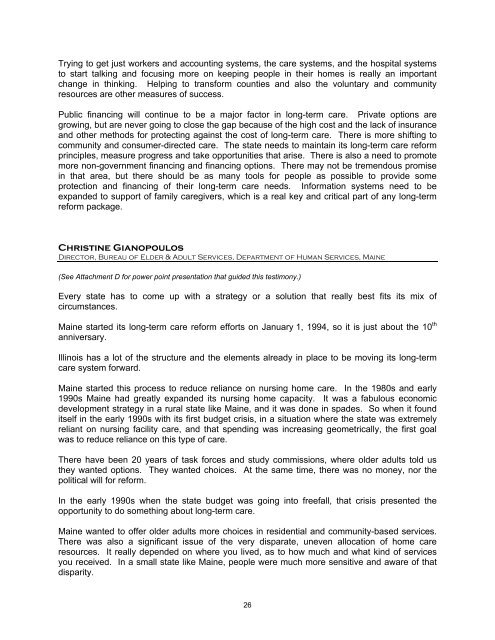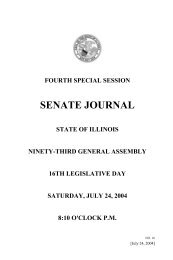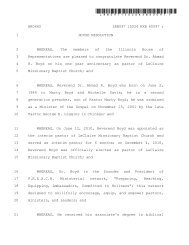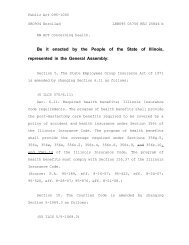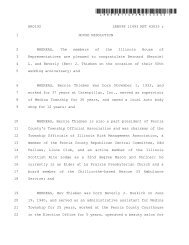Long-Term Care - Illinois General Assembly
Long-Term Care - Illinois General Assembly
Long-Term Care - Illinois General Assembly
Create successful ePaper yourself
Turn your PDF publications into a flip-book with our unique Google optimized e-Paper software.
Trying to get just workers and accounting systems, the care systems, and the hospital systems<br />
to start talking and focusing more on keeping people in their homes is really an important<br />
change in thinking. Helping to transform counties and also the voluntary and community<br />
resources are other measures of success.<br />
Public financing will continue to be a major factor in long-term care. Private options are<br />
growing, but are never going to close the gap because of the high cost and the lack of insurance<br />
and other methods for protecting against the cost of long-term care. There is more shifting to<br />
community and consumer-directed care. The state needs to maintain its long-term care reform<br />
principles, measure progress and take opportunities that arise. There is also a need to promote<br />
more non-government financing and financing options. There may not be tremendous promise<br />
in that area, but there should be as many tools for people as possible to provide some<br />
protection and financing of their long-term care needs. Information systems need to be<br />
expanded to support of family caregivers, which is a real key and critical part of any long-term<br />
reform package.<br />
Christine Gianopoulos<br />
Director, Bureau of Elder & Adult Services, Department of Human Services, Maine<br />
(See Attachment D for power point presentation that guided this testimony.)<br />
Every state has to come up with a strategy or a solution that really best fits its mix of<br />
circumstances.<br />
Maine started its long-term care reform efforts on January 1, 1994, so it is just about the 10 th<br />
anniversary.<br />
<strong>Illinois</strong> has a lot of the structure and the elements already in place to be moving its long-term<br />
care system forward.<br />
Maine started this process to reduce reliance on nursing home care. In the 1980s and early<br />
1990s Maine had greatly expanded its nursing home capacity. It was a fabulous economic<br />
development strategy in a rural state like Maine, and it was done in spades. So when it found<br />
itself in the early 1990s with its first budget crisis, in a situation where the state was extremely<br />
reliant on nursing facility care, and that spending was increasing geometrically, the first goal<br />
was to reduce reliance on this type of care.<br />
There have been 20 years of task forces and study commissions, where older adults told us<br />
they wanted options. They wanted choices. At the same time, there was no money, nor the<br />
political will for reform.<br />
In the early 1990s when the state budget was going into freefall, that crisis presented the<br />
opportunity to do something about long-term care.<br />
Maine wanted to offer older adults more choices in residential and community-based services.<br />
There was also a significant issue of the very disparate, uneven allocation of home care<br />
resources. It really depended on where you lived, as to how much and what kind of services<br />
you received. In a small state like Maine, people were much more sensitive and aware of that<br />
disparity.<br />
26


